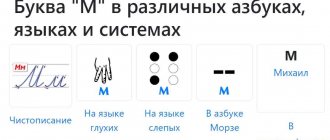Every person's speech consists of sounds. The child’s development depends on how correctly the letters are pronounced. If a child under 5–6 years old makes mistakes in reproducing phonemes, you should seek help from a specialist.
Recently, incorrect pronunciation of the letter D has become increasingly common among children. To eliminate the defect, the sounds “D” and “D” should be produced and automated.
Types of deviations
Characteristics of pronunciation defects:
Consonant voiced
Stun.
the sound “D” at different positions in words turns into
steam room
deaf
I agree
"T". The disorder occurs due to the similarity in the location of the articulatory apparatus during reproduction, poor development of phonemic perception and organic deficiencies of the speech organs. The defect is eliminated again using the phoneme “B”.- Open twang. Replacing the sound
“D” with “N”. The sky curtain is down. The tip of the tongue does not push away from the incisors. There is no push of the air stream from the oral cavity. The air leaves the nasal cavity in a continuous manner. - Clicking "D". Correction is carried out by regulating breathing during pronunciation.
You can check correct reproduction in the form of a small test, suitable for older
groups
of preschoolers
:
- An adult pronounces sentences with frequent letter repetition. For example, Dina blows a trumpet. The child is asked to repeat what he heard.
- Using illustrations of objects with the sounds “D” and “D”. Place the pictures
in front of the child. Ask to name what is depicted on them (oak, house, melon, children, hollow, etc.) - Search for the desired picture. The adult says the name of one depicted object among the presented pictures, and the child finds it and names it.
Such simple tasks are used in preparatory groups
to identify defects in sound pronunciation and to develop the thinking abilities of children. Similar activities are used for all types of phonemes.
Causes of pronunciation problems
The occurrence of incorrect reproduction of soft and hard
"D" is accompanied by:
- lack of correct articulation
of the speech organs; - underdevelopment of phonemic hearing (the child does not distinguish sounds from each other);
- repeating the mistakes of others;
- weak motor activity of the lower jaw and other organs of the speech apparatus (occurs with dysarthria).
Don't miss: The easiest ways to make the sound H
Note: dysarthria is a violation of the innervation of the speech organs. The deviation appears due to damage to the central nervous system.
It is possible to establish an accurate diagnosis and cause after speech therapy
examinations.
After collecting a detailed history, the speech therapist
prescribes corrective
tasks
. Some classes should be done at home.
Correct articulation for the sounds D and D
When playing the sound “D” the speech apparatus takes the position:
The lips are completely neutral. The production depends on the subsequent vowel phoneme. The distance between the lips and incisors is about 5 mm.- The tip of the tongue rests on the upper jaw. May touch the alveoli behind the upper teeth.
- The soft part of the palate descends.
- The larynx vibrates.
- The vocal folds are closed. Presence of voiceover.
The articulation of the soft “D” differs from the hard one only in the position of the tongue. Its tip falls behind the lower incisors.
Important: Classes aimed at establishing phonemes should be conducted after the child has mastered simple vowels and consonants (a, y, o, i, e, s) and (b b, p p, mm, v v, f f).
Recommendations for producing sounds for various speech disorders
Phonetic-phonemic speech underdevelopment (FFSD).
The production of sounds during FFNR is carried out with the maximum use of all analyzers. Children's attention is drawn to the basic elements of sound articulation during the period of its evocation.
The following is taken into account:
- for the initial production, sounds belonging to different phonetic groups are selected;
- sounds mixed in children's speech are gradually worked out in a delayed manner;
- the final consolidation of the studied sounds is achieved in the process of differentiation of acoustically close sounds.
From the very beginning of learning, it is necessary to rely on conscious analysis and synthesis of the sound composition of the word.
Hearing impairment.
In case of impaired hearing, a defect in voicing is observed. If voicing is completely impaired, work begins with fricative sounds, and with the simplest of them in articulation - [B]. After it they move on to the sounds [Z] and [Zh], and then to plosives in the sequence: [B], [D], [G].
You can achieve voicing of a sound thanks to a direct transition to it from one of the sonors - [M], [N], [L], [R] (mmmba, nnnba). At the beginning, the speech therapist focuses the child’s attention on the clarity of correct pronunciation in general, i.e. clarity and correctness of pronounced sounds and correct stress, then deals with the production of sounds (usually S, Ш, Ж, Р, Б, Д, Г) and their automation in the child’s dictionary. The main thing in working with hearing-impaired children is visual and tactile control.
Stuttering.
Corrective work on sound pronunciation is carried out in parallel with the correction of stuttering. Evoking sounds begins with the easiest and most preserved ones. A detailed defect analysis is of particular importance. The process of working on sounds is similar to working with dysarthria. Ways and methods of producing sounds for stuttering are used as for dyslalia.
Dysarthria.
Corrective work for dysarthria is complex and includes work on:
- normalization of muscle tone;
- strengthening the perception of articulatory patterns and movements through the development of visual-kinesthetic sensations;
- development of conditioned connections between movement, voice and breathing.
Speech therapy work is carried out against the background of medication, physiotherapy, physical therapy and massage; if necessary, a reflex-inhibiting position is used.
Working on sounds with dysarthria has its own characteristics:
- It is not necessary to immediately achieve complete purity of sound; polishing each sound should be carried out over a long period of time, against the backdrop of ever-developing, increasingly complex work on other sounds.
- It is necessary to simultaneously work on several sounds belonging to different types.
- The sequence of work on sounds is dictated by the gradual complication of articulatory settings and the structure of the defect.
- First of all, phonemes with the simplest articulation or more intact pronunciation are selected for correction. In practice, it often happens that sounds that are more complex in articulation are less disturbed.
- Before evoking sounds, it is necessary to distinguish the phoneme by ear. The child must also learn to recognize the difference between his pronunciation and normal sound. In the process of work, it is necessary to establish inter-analyzer connections between the movement of articulatory muscles and their sensation, between the perception of a sound by ear, the visual image of the articulatory structure of a given sound and the motor sensation when pronouncing it. The most common method is phonetic localization. When a speech therapist passively gives the child’s tongue and lips the necessary position for a particular sound. Many exercises are carried out without visual control, drawing the child’s attention to proprioceptive sensations. Particular attention should be paid to the pronunciation of vowel sounds, which contribute to the activation of the soft palate and jaw movement.
Alalia (ONR).
Speech therapy work can only be effective if it is carried out comprehensively against the background of active medication and physiotherapeutic treatment carried out by a neuropsychiatrist.
Speech therapy work on sound pronunciation is closely related to the development of children's vocabulary. When expanding the vocabulary or working on a phrase, individual sounds appear in children's speech. At the initial stage, work is needed to clarify vowel sounds and pronounced consonants.
When setting and consolidating, the sequence of assimilation of sounds in a certain position in a word is of great importance. The most successful way to fix a sound is at the end of a word, then at the beginning of a word, a sound in a position between two vowels, a sound in a confluence before a consonant, a sound in a confluence after a consonant.
Work on sounds during alalia or OHP is carried out in stages:
- development of an oral image of the pronounced sound;
- development of kinesthetic sensations of the speech motor analyzer.
Exercises aimed at compensating apraxic disorders.
- Development of differentiated movements of the tongue and lips.
- Development of conscious differentiated movements of the tongue (raising the tip of the tongue, the front or back of the back of the tongue) to close with different parts of the palate.
- Development of differentiated movements of the lips and tongue in various ways of producing sounds (differentiation of stop and fricative).
- Development of conscious differentiated movements of the tongue (tip and back) for the formation of frication.
- Development of differentiated movements of the lips and tongue for the formation of palatoglossus and labiolabial friction.
As an auxiliary technique for motor alalia, early literacy training is used, and for sensory alalia, repetition of the heard phrase and elements of lip reading are also used. A child’s lack of certain sounds is not a serious obstacle to memorizing letters and mastering the technique of sound merging. The child gradually develops the connection between phoneme, grapheme and articule.
Aphasia.
With afferent motor aphasia, the call of sounds begins with the imitation of labial and front-lingual, as well as contrasting vowel phonemes A and U. The speech therapist calls sounds by imitation, and then adds the sounds m and v.
When working on sound pronunciation in aphasia, a number of features should be taken into account:
- sounds of one articulatory group cannot be evoked;
- sounds should not be introduced into nouns in the nominative case, but into words and phrases necessary for communication (ok, I will, tomorrow, today, etc.).
The interrelation of two processes - the formation of the syllabic structure of a word and the pronunciation of sounds included in the word - causes the pronunciation of a new difficult sound.
Rhinolalia.
Planning work to correct pronunciation for rhinolalia is recommended in the following sequence:
- Vowels A, E, O, U, Y. Consonants P, F, V, T, K, X, S, G, L, B and their soft variants.
- Sounds: I, D, Z, Sh, R.
- Sounds: Zh, Ch, C.
In the process of posing phonemes, it is necessary to involve visual, auditory and kinesthetic analyzers. Reliance on kinesthetic and visual control helps to become familiar with the sensation of moving the tongue forward and the degree of tension in the organs of articulation.
Particular importance is given to the ability to sense directed exhalation. Production of sounds begins only after correct speech breathing has been formed. The evocation and automation of sound occurs on a very calm exhalation with concentration of attention not on the sound, but on the correct exhalation. The mechanical method of pinching the nose should be done with one finger, while pressing the wing of the nose against the face, and not the nasal septum.
Taking into account the degree of activation of the soft palate, fricative voiceless consonants are placed first in the sequence: F, S, Ш, Ш, Х.
They start with the sound [F], since it is the easiest and most accessible in terms of articulation. The child is asked to place the lower lip to the upper teeth and exhale through the middle of the mouth. Turning on the voice, we get the sound [B]. Explosive sounds in the work are more complex due to their short duration, so the production is carried out later. To obtain the sound [P], you can ask the child to exhale forcefully with his lips tightly compressed, at this time using his index finger to alternately close and open the lower and upper lips.
The sound [T] can be caused by interdental pronunciation of the sound [P] or [S].
Pravdina O.V. recommends putting sounds, both vowels and consonants, first without voice. Naming a sound, as well as fixing it with a letter, is allowed after accurately pronouncing it in a whisper.
The pronunciation of vowels is formed on a firm attack, loudly, without shouting or tension (“in a mask”). Practicing the vowels A, E, O, Y, U prepares the articulatory apparatus for the production of hard consonants, and the sound [I] for soft ones.
Correction of posterior palatal sounds is impossible with a narrow, gothic palate or with a pronounced shortening of the soft palate. In such cases, the pharyngeal articulation of sound should not be inhibited, since it differs slightly from the normal sound. Children with reduced kinesthesia and phonemic hearing disorders have to use analogue sounds at first.
If there is a proto [P], we put [W] from the whispered form []P with teeth close together and lips rounded. If the child finds lower articulation [Ш] easier, then we introduce it into speech.
When staging sounds Povalyaeva M.A. recommends the use of mechanical assistance in extreme cases, since mechanical assistance makes it difficult to introduce sound into speech. It is important to take into account that evoking sound through interdental articulation delays the pace of work. With rhinolalia, it is not recommended to pronounce consonant sounds in a drawn-out, exaggerated manner, since tension and exhalation increase and the time of the bow lengthens.
Exercises for staging
Before you begin to master the phoneme, you should go through the preparatory stage. It consists of performing special articulation and breathing exercises (here). The child must be taught correct articulation (position of the speech organs) and breathing during the pronunciation of an isolated sound.
Articulation gymnastics
The classes are designed to train the organs involved in the pronunciation of the sounds “D” and “D” description
:
- Lower jaw. Open your mouth wide. Use your lower jaw to imitate chewing movements. Perform for 10-15 seconds.
- Lips and cheeks:
- lips are closed, and air should be drawn into the oral cavity. Next, imitate rinsing as after brushing your teeth in the morning;
- use your lips to make characteristic sounds for a horse (snorting);
- pouting lips in turn. First the top, then the bottom.
3. Language:
Exercise "Mushroom"
- "Fungus". Smile widely with your mouth open. The flat tongue is sucked to the palate. In this case, the organ should be located behind the upper incisors. Hold the position for 10-15 seconds.
- "Horse". Click your tongue on the hard palate, imitating the sound of a horse's hooves.
- "Swing". Open your mouth wide, slightly exposing your teeth. Place the tongue behind the upper and lower teeth in turn. Performed 5 times.
Don't miss: The simplest and most effective ways to make the sound R and Rb
4.Soft palate. The baby is asked to reproduce vowel sounds. The pronunciation is soft at first, and then a hard attack is applied.
Advice: to prevent your baby from getting bored with doing the same exercises, you can use classes prescribed for speech therapists. Many options are available on the Internet.
Breathing exercises
Experts suggest performing paradoxical gymnastics according to Strelnikova. But its use is allowed for children 7-8 years old ( grade 1
). Exercises should be performed under the supervision of parents or a specialist. Initial exercises:
- Palms. The child stands up straight. He bends his arms at the elbows and shows his palms to the adult. Hands clench into fists as you inhale and unclench as you exhale. You need to breathe through your nose. Perform the exercise 4 times.
- Shoulder straps. The baby is standing upright. Hands clenched into fists. They are pressed to the belt. While inhaling, hit the floor with your fists. Gradually unclenching your hands. As you exhale, return to the starting position. Do it 4 times.
- Pump. From a level stance, make a slight forward bend. The arms are hanging at the sides. Simulate tire inflation. Lean forward and inhale. As you exhale, return to the bent position.
Important: the technique has many contraindications, so you should consult a pediatrician before performing it.
To train children's breathing, use the “tube” exercise. The lips are pulled forward. Inhale through the nasal cavity, exhale a stream of air using a formed tube. Perform 4-5 times.
Articulation gymnastics
Experts suggest using speech therapy techniques to develop speech breathing (since T is formed during explosive exhalation), and to train the muscles of the oral cavity in a playful way:
- “Whose dandelion will fly away first?” — in the summer, at the dacha, the guys pick dandelions and try to blow away all the fluff in 3-4 times.
- “Balloons” - blow on the balloons, preventing them from falling to the floor.
- “Smile” - close your teeth, stretch your lips wide, hold a smile for 5 seconds.
- “Punish the tongue” - put the tongue on the lower lip, tap on it with the upper lip: pa-pa-pa.
- “Spatula” - smile, stick out tongue, relax, place on lower lip, hold for 5 seconds.
- “Tick-tock clock” - quickly move the tip left and right along the upper lip.
- “We’re brushing our teeth,” they smile. The tongue “goes around” all the teeth from left to right and back.
- “Tube” - stretch the tongue as much as possible, tense it. They try to roll it into a tube and hold it for 5 seconds.
- “Swing” - open your mouth slightly, alternately pull your tongue towards your nose and chin, trying to reach them.
- “Slide” - first, the front edge is firmly pressed against the lower incisors, then the wide part (at the same time it bends). Fix the position for 5 seconds.
Staging
It is carried out after the child has mastered the position of the speech organs when reproducing a phoneme. Typically, 2 methods of producing the sound “D” and “D” are used:
. The baby and the adult sit in front of the mirror. A parent or specialist demonstrates the correct pronunciation of the sound. The child is asked to repeat. To make it easier, vowel sounds are used. For hard “D” (da – do – du – dy), and for soft “D” (di – du – de).
Imitation- Mechanical method. The child pronounces the sound “B”. The tongue is between the lips at this time. The speech therapist uses a special spatula to press on the tip of the organ. Then he pushes it behind the upper incisors.
Don't miss: What is articulatory gymnastics and how is it performed?
Experts often offer these methods of setting as homework.
. In a familiar environment next to a loved one, the baby will master classes faster.
Important: when performing exercises, point out the distinctive characteristics of the phoneme “D” from “T”. A special feature of the sound “D” is the vibration of the vocal folds. In order for the baby to feel the difference, his hand is placed on the larynx of an adult, who pronounces the letters in turn.
We put the sounds [K], [G], [X]
The sound “K” is made mechanically using a spatula. The articulation looks like this:
- the lips should take the position of the next vowel sound;
- You can’t keep your teeth closed;
- the tip of the tongue needs to be lowered and touched with it to the incisors of the lower dentition;
- the lateral parts of the tongue are adjacent to the upper lateral teeth;
- the back of the tongue should form a bow with the palate;
- the soft palate rises at this time, blocking the passage to the nasopharynx;
- there is no need to strain the vocal cords, they are open;
- During exhalation, the resulting stream of air should explode the bow, causing a characteristic sound.
The first version of the production is from the sound “T”. It is used if the child pronounces the sound “T” clearly, cleanly, without unnecessary overtones.
Invite your baby to play the sound “TA”. At the same time, press the spatula on the front part of the back of the tongue, as a result of which the sound “TY” will be heard. Next, you need to move the spatula a little further into the depth, which will provoke the pronunciation of the sound “KY”. Even deeper pressure on the tongue gives a clear pronunciation of the sound “KA”. The use of the mechanical method is stopped when the child remembers the location of the articulatory organs for pronunciation of the sound being studied.
The sound “K” can be made while inhaling. This exercise is reminiscent of imitation snoring - silent or whispering. Encourage your child to snore for fun. After the exercise, you can hear a sound reminiscent of “K”. Invite your child to say “KA” while inhaling and exhaling. After this, automate the sound traditionally: “KA-KO-KU-KI-KE-KYO.”
The articulation of the sound “G” is similar to the articulation of the sound “K”. However, the voice is involved in this process - the vocal cords must close and vibrate during exercise.
The sound "G" can be placed from "Y". To do this, invite the child to throw his head back and, while exhaling strongly, say “YYYYY”, simultaneously pushing his lower jaw forward, raising it and lowering it. By analogy with the production of the sound “K” from “TA”, you can place the sound “G” from “DA”.
The articulation of the sound “X” differs from “K” in that the back of the back of the tongue should form not a bow with the palate, but a gap along the midline. The sound “X” can be made like this: invite the child to open his mouth the width of two fingers and blow warm air on his palms. If the sound does not work, you can try throwing your head up in the process. The sound “X” can be placed from “S” and “Sh”. They use a mechanical method: when the child pronounces these sounds, you need to use a spatula to move the tongue deeper into the mouth.



